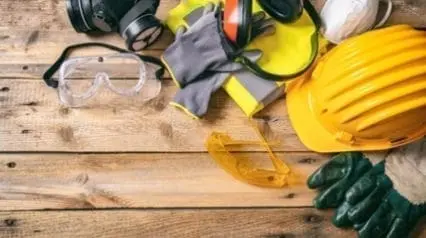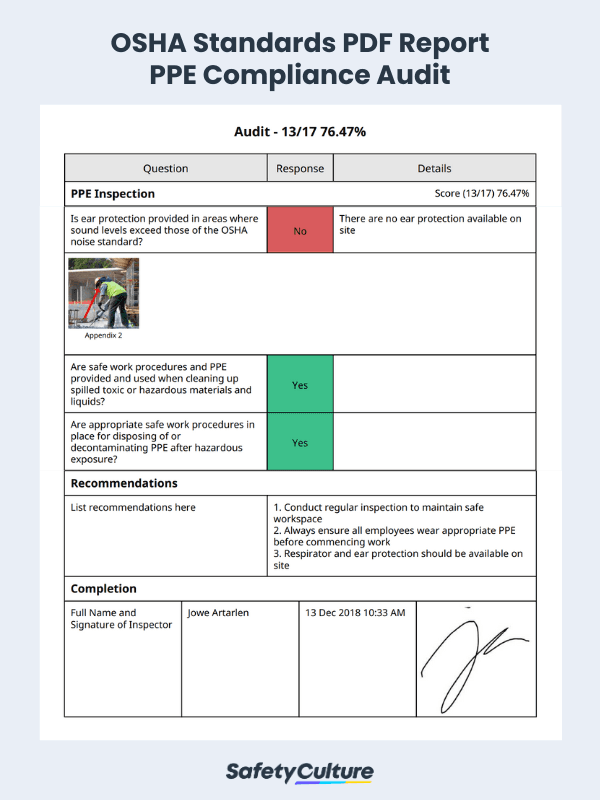What are OSHA Standards?
OSHA standards are sets of guidelines and requirements enforced by the Occupational Safety and Health Administration (OSHA) to minimize health and safety risks in US-based workplaces. They regulate companies to maintain safe and healthy working conditions and to provide suitable training and assistance to their employees before doing their jobs. OSHA standards are also known as OSHA regulations or OSHA requirements because they are stipulated in Part 1910 Title 29 of the U.S. Code of Federal Regulations (CFR).
OSHA Safety Standards
An OSHA safety standard is a list of material and equipment requirements along with guidelines and instructions for employers to minimize employee risk in the performance of work. Adherence to OSHA standards protects workers from fatal hazards and health risks. It is organized into four major industries.
OSHA Safety Standards Example 1: General Industry
This section outlines OSHA’s occupational safety and health requirements, covering businesses that do not fall strictly under the agriculture, construction, and maritime industries. Employers must do the following:
- Provide the appropriate personal protective equipment (PPE) to each employee where necessary. This includes respirators, safety glasses, face shields, earplugs, protective gloves, flame-resistant clothing, etc. Failure to provide the appropriate PPEs may place the employer in violation of OSHA standards for each employee.
- Provide the appropriate safety training to employees, either in-house or through third-party means, to adequately prepare them for hazards they may encounter at work.
- Ensure that all areas used for work, including production floors, storage rooms, and walking surfaces, are kept clean, orderly, and sanitary.
- Ensure that all walking-working surfaces are strong enough to support the combined weight of workers, equipment, and machinery situated in the above-mentioned area.
- Ensure that walking-working surfaces are free of hazards, including sharp/protruding objects, loose floorboards, chemical leaks, spills, snow, and ice.
- Ensure that employees have access to safe entry and exit points to and from walking-working areas.
- Ensure that walking-working surfaces are inspected and maintained regularly and as necessary to preserve safe conditions.
- Ensure that hazardous walking-working areas are corrected or repaired before employees are allowed access to said areas again. If correction or repair cannot be done immediately, access must be closed off until necessary corrective measures have been taken.
- Provide portable fire extinguishers and ensure they are readily accessible to employees.
- Employers are responsible for the inspection, maintenance, and testing of portable fire extinguishers and other related assets in the organization.
To help improve the safety of workplace officers, listed below are OSHA standard checklists for the general industry.
OSHA Safety Standards Example 2: Construction
This section talks about some of the most prominent employer responsibilities in the construction industry:
- Ensure that employees are adequately trained and experienced to operate equipment and machinery.
- Ensure that first aid services and medical provisions are available for all employees.
- Provide and require employees to wear appropriate personal protective equipment (PPE) in all operations where hazardous conditions are present.
- During the course of construction work, employers must ensure that harmful debris, such as scrap lumber, protruding nails, and others, is cleared from work areas.
- Ensure that adequate illumination, whether natural or artificial, is available in walking-working areas where work is in progress.
- Where there are harmful sound levels, employers must utilize feasible administrative and engineering measures. If such measures fail, employers must ensure that employees have access to PPE that protects them from excessive noise exposure and harmful sound levels.
- Provide fall protection, such as guardrails, safety nets, and safety harnesses, to employees working at a height of six feet or more.
- Employers are responsible for the development and consistent implementation of an effective fire protection and prevention program for the entire duration of construction, repair, alteration, and/or demolition work.
- Ensure that all electrical equipment used at the job site is safe and free from recognized hazards that may cause injury or death.
- Ensure that pressure vessels and boilers have a current and valid certification from an insurance company or regulatory authority as evidence for safe installation, inspection, and testing.
Browse these OSHA standard checklists for the construction industry.
OSHA Safety Standards Example 3: Maritime
In the maritime industry, meanwhile, employers should do the following:
- Ensure that atmospheric testing is done for oxygen content, flammability, and toxicity, in that order.
- Ensure that the following spaces are inspected and tested by a qualified person to determine the atmosphere’s oxygen content before employees are allowed entry:
- Sealed spaces, including but not limited to spaces that have been coated and non-ventilated spaces that have been freshly painted
- Spaces that contain or previously contained flammable liquids and/or gases, and corrosive liquids, gases, or solids
- Spaces that have been fumigated
- Spaces that contain materials or elements that reduce the oxygen in the atmosphere
- Ensure that all rooms determined to be oxygen-deficient or oxygen-enriched are labeled “Not Safe for Workers.”
- Ensure that the oxygen content of all rooms and spaces is within the range of 19.5 percent to 22.0 percent. All rooms and spaces whose oxygen content falls outside of the accepted range shall be labeled “Not Safe for Workers.”
- Ensure that each employee, as well as anyone who enters confined spaces and other dangerous atmospheres, are properly trained to exit the space in instances where:
- An authorized person orders an evacuation
- An evacuation signal or alarm is activated
- The person determines that he or she is in danger
- Establish a shipyard rescue team or hire a third-party rescue team ready to quickly respond to rescue requests:
- Should an employer establish their own shipyard rescue team, each employee assigned to the team must receive adequate training to perform his or her rescue duties, which include entry into confined areas as well as other areas with a dangerous atmosphere.
- Employers must ensure that shipyard rescue teams practice their skills via practice drills every 12 months using equipment and facilities that can effectively simulate a real rescue situation.
- When a change made in a vessel could alter conditions in a confined space and introduce possible hazards, work in the affected space must be stopped and can only be resumed once the safe status has been re-established through proper inspection and testing.
The following OSHA standard checklists for the maritime industry can help employers ensure a healthy environment for their employees.
OSHA Safety Standards Example 4: Agriculture
Lastly, for the agriculture industry, employers must:
- Ensure that each tractor used by employees for work has a working seatbelt sufficiently tightened to keep the worker confined in the safe area within the operator’s station.
- Ensure that batteries, fuel tanks, oil containers, and coolants are placed and sealed in an area where employees are protected from possible spillage.
- Ensure that the protective frames of wheel-type tractors used by employees have undergone and passed standard laboratory and field-upset tests to certify its effectiveness in preventing injury due to accidental upsets.
- Ensure that employees assigned to operate machinery are adequately trained in the safe operation and servicing of agricultural equipment including the minimum safe practices mentioned below:
- Keep all guards in place during machine operation.
- Permit no other riders on the equipment other than the operator and necessary personnel.
- Stop the engine, disconnect it from the power source, and ensure that the machine has stopped completely before performing repairs or cleaning, except in instances where the machine must be running to be properly serviced.
- Provide free, clean drinking water to employees who work in the field:
- The water must be cool enough and sufficient, considering the air temperature and humidity, as well as the nature of their work, to meet the needs of all field workers.
Browse these OSHA standard checklists for the agricultural industry:
OSHA Functions
Essentially, OSHA operates with two main functions—as a safety enforcer and as a safety consultant:
1. Safety Enforcer
OSHA’s most prominent function is to ensure that employers and employees all over the United States comply with their safety standards. Failure to comply with OSHA’s standards can lead to hefty fines, legal consequences, and a tarnished reputation. OSHA’s compliance safety and health officers visit workplaces and perform on-site inspections to identify and point out potential safety hazards to employers and employees.
2. Safety Consultant
OSHA provides free safety consultations to employers upon request. Through this function, an OSHA consultant will perform a walkthrough inspection with the employer in order to identify workplace hazards, provide helpful suggestions on how to eliminate safety issues, and assist employers in developing and maintaining an effective safety and health program. Additionally, OSHA consultants can also provide safety training for both the employer and employees on-site or off-site, subject to approval.
Improve your GRC management
Simplify risk management and compliance with our centralized platform, designed to integrate and automate processes for optimal governance.
Explore nowOSHA Coverage
OSHA covers all private-sector workers in all 50 states. State and local government workers only have OSHA coverage if they work in states that have OSHA-approved programs. Self-employed workers and workers protected by other federal agencies, such as the Mine Safety and Health Administration, are not covered by OSHA.





